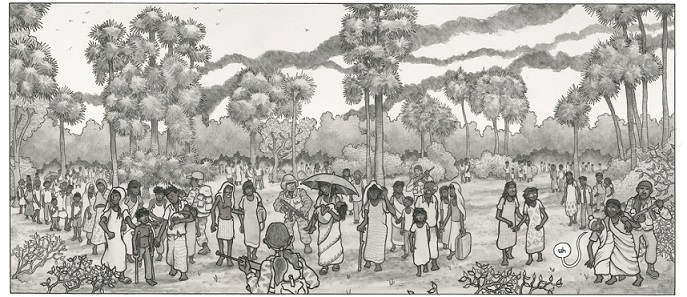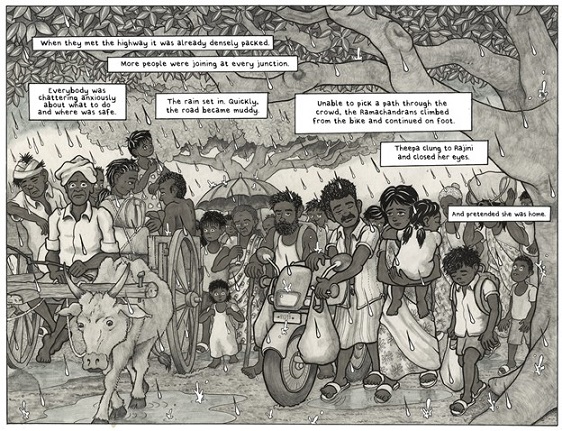ERASING THE EELAM VICTORY Part 21 D1
Posted on July 15th, 2021
KAMALIKA PIERIS
When Eelam war IV started in 2006, Tamil civilians had followed the retreating LTTE across the Northern Province, to their shrinking area of control in Mullaitivu and became trapped between the two armies. They went voluntarily.
The map given below shows the movement of Vanni population from September 2007- September 2008. They are moving towards the war zone.

- hpsl.lk stands for Humanitarian Portal – Sri Lanka (UNOCHA).
- ONOCHA means United Nations Office for the Coordination of Humanitarian Affairs.
- the map was downloaded from https://www.scribd.com/document/132499266/The-Numbers-Game-Politics-of-Retributive-Justice
When Eelam War IV started, Tamil civilians left their villages and trekked to the east thinking that eventually LTTE would win and they could return home, said Kusal Perera. LTTE had instructed them to remove roofs, doors and windows of their houses, when they left. They did so.
Kusal Perera met such a family in Menik Farm. This family had been travelling from west to east for three years. They were from Adampan in Mannar. Adampan was under the LTTE for the past 20 years. The daughter told Kusal, whenever the Sri Lanka army started firing shells and mortar and entered our village we have to leave the village. Then after a month or two we come back. Tiger army takes over and announces that we can return.
In July 2006, after the Mavil Aru closure, the army started shelling Adampan. The shelling was intense. People moved out and army came in. Her family packed everything and left in a tractor. they thought they would return in a month or two as before. Some even took their livestock with them said the daughter.
They settled first in Palliyaru. That was shelled, so they moved east with the whole village. Next stop Jeyapuram. Then east again. Kusal’s informant, the daughter said they still believed the LTTE would fight the army and regain lost territory for them to return home. Instead they kept moving east all the time .They eventually got to Dharmapuram near Visvamadu in August 2008. Kilinochchi was still under LTTE so they thought that would be the limit for advancing forces. This statement by the daughter shows that these civilians were alertly watching the progress of the war.
LTTE then told them to move further east and they shifted to Mungil Aru south with the rest of the exodus. they were forced to keep moving, Kusal’s informant told him. They kept walking toward Mullaitivu , then to Pudumathalan, arriving there on 19 April, 2009 with the rest of the massive crowd. They seem to have travelled on A35 road. For a week they had shared a sandy bunker with 12 other families, the daughter said. The army too reported that civilians had moved into Mungil Aru, Sudthanithirapuram, Devipuram and Irrittumadu areas located north of the Paranthan-Mullaitivu Road.
In 2019, Bejamin Dix produced a cartoon book on Tamil refugees, which included the last stages of the Eelam War. the book followed the fortunes of one fictionalized Tamil family.
The book was titled, ‘Vanni, a family’s struggle through the Sri Lanka conflict, by Bejamin Dix illustrated by Lindsay Pollock,( Penguin Random House, 2018.) It was funded by Arts Council of England. it was thereafter issued by New Internationalist (UK & Europe), Penn State University Press (USA and Canada), and Penguin India.

Dix and Pollock decided on telling the story through a ‘comic book’. they thought it a good way reach the public. Comics reach a different readership than journalism. Cartoon books connect with people in a different way. The initial impulse for the book was publicity, to alert the general public to the injustice which had befallen the Tamils. It was intended to educate and campaign.

Benjamin Dix told the newspaper Indian Express, I left Vanni with a huge collection of interviews, photographs and reports, along with my own lived experiences and relationships within the Tamil community. A deep sense of shame and guilt engulfed me as I drove out of Kilinochchi in the last UN convoy on 16 September 2008.”
I wanted to turn what I was seeing in Vanni into a graphic novel, depicting the displaced people, the carnage, our impotence at the UN and the many stories of human suffering,” he told the interviewer.

For the international media, the war remained largely a story of freedom” from a terrorist organization. But that did not take into account the hundreds of displaced Tamilians, on the move, dying as shelling continued, or of the many others who were disappearing” into internment camps. Sri Lanka is especially important, because, Dix said, 10 years on, there still has not been any credible sense of closure and justice for the victims. (continued in D2)